The OnePlus 3 Review
by Brandon Chester on June 20, 2016 8:00 AM EST- Posted in
- Smartphones
- OnePlus
- OnePlus 3
GPU Performance
GPU performance is one of the areas where Snapdragon 810 actually tended to do quite well. It's also the case that GPUs generally see larger performance gains year over year than CPUs. We already saw how Adreno 530 performs in the LG G5 review, but the device being compared to was the LG G4, which used Snapdragon 808. The OnePlus 3 represents an opportunity to compare a Snapdragon 810 device to its successor using Snapdragon 820.
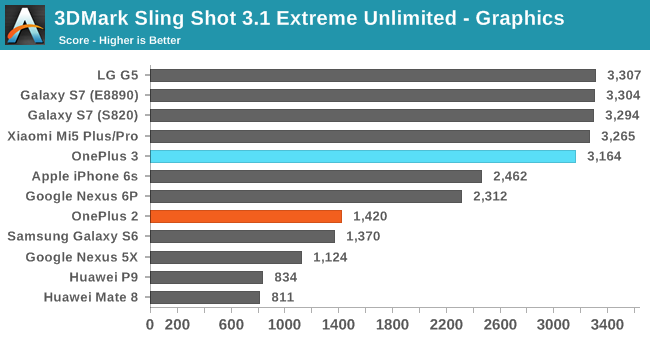
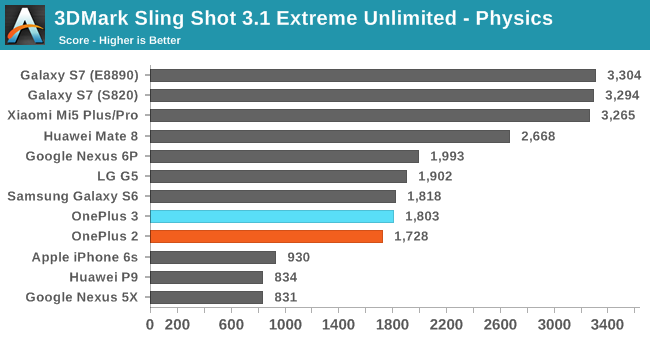
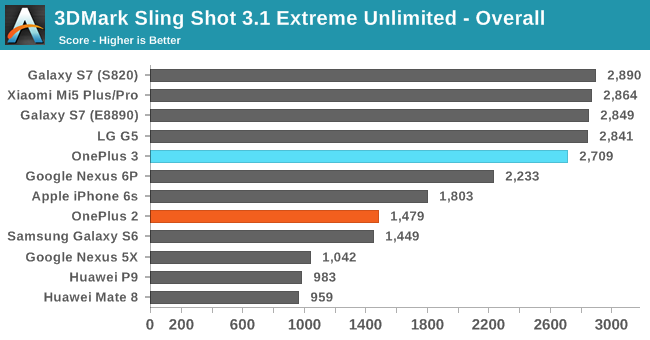
The OnePlus 3 does very well in 3DMark Sling Shot. In both the physics and graphics tests it trails the LG G5 slightly, but the gap isn't anything truly significant. Exynos 8890 is still not something I can compare to until our Galaxy S7 review is posted, but barring that it's clear that Snapdragon 820's Adreno 530 gives the fastest smartphone performance in this test, and when looking at the graphics performance the performance is over two times faster than the OnePlus 2.
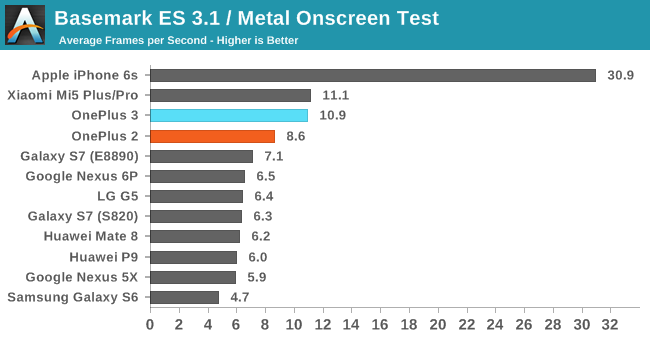
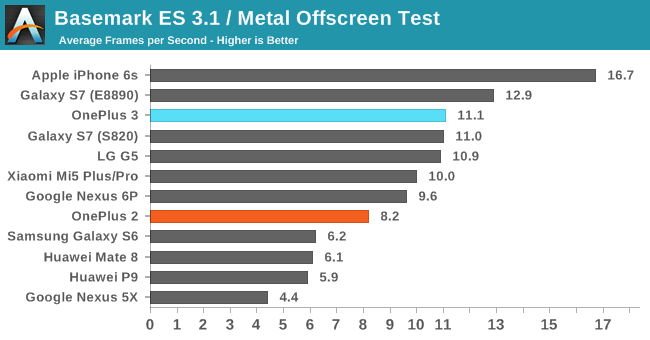
In BaseMark ES 3.1's on screen test the OnePlus 3 manages a significant lead over the LG G5 as a result of its lower resolution. In the off screen 1080p test both phones have essentially the same performance, which is what you'd expect. It looks like Adreno 530 doesn't make the same gains in this test that it does in some others, and it's not clear whether this is just the result of driver optimizations or something about the benchmark that is able to perform batter on other GPU architectures, which could be contributing to the iPhone's lead even in the off screen test.

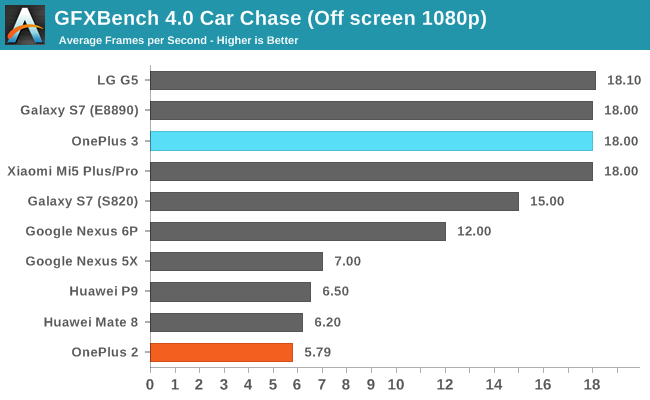
In GFXBench Car Chase the performance of the OnePlus 3 is in line with the LG G5. On screen performance is significantly higher due to the lower resolution display, while off screen performance at 1080p is about the same as the G5 and exactly the same as the on screen result. As far as absolute GPU performance goes, both of our Snapdragon 820 devices are at the top of the chart for absolute performance, and that's good news for anyone playing games or using software that benefits from a powerful mobile GPU.
NAND Performance
The OnePlus 3 moves to a UFS 2.0 NAND solution, which OnePlus claims is three times faster than the eMMC storage used in the OnePlus 2. In more realistic testing you probably won't end up achieving speeds three times faster than the OnePlus 2 since it actually wasn't slow at all by eMMC standards, but there should be a decent uplift in NAND performance nonetheless.
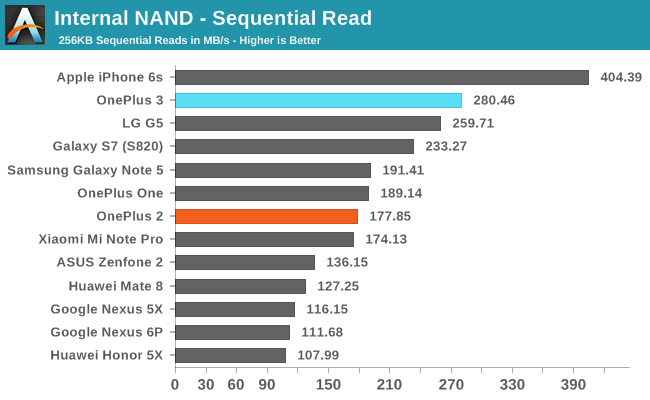
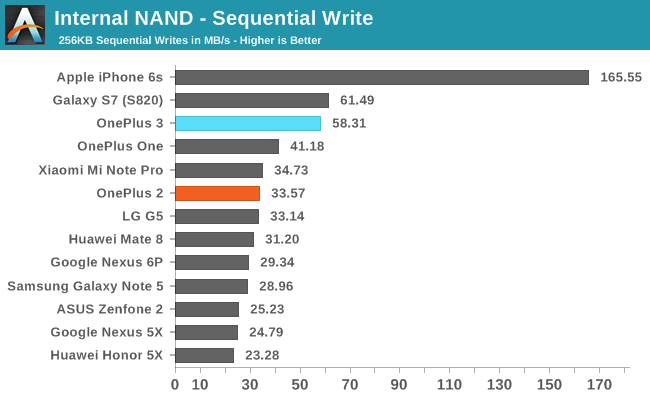
The move to UFS 2.0 brings healthy gains over the OnePlus 2's storage performance, although as I said, the OnePlus 2 didn't perform poorly at all by the standards of eMMC devices. Sequential read and write performance is actually the best that I've measured so far on an Android device. We're still not looking at anything close to what you get for sequential performance on iOS devices, but there are some other factors at play like the fact that the iPhone was a 128GB unit while our Android devices are usually 32GB or 64GB devices. In any case, the OnePlus 3 doesn't present any problems with storage performance, and you certainly won't run into the same issues that you can with budget smartphones at the $200-300 range where the eMMC solutions can be exceptionally slow.










176 Comments
View All Comments
greyhulk - Monday, June 20, 2016 - link
Bragging that your phone has 6GB of RAM, while knowing that you gimped it so that it doesn't utilized it is pure insanity. The co-founder has gone on record saying this was intentional to save battery (yet the put a smaller battery in). I would have thought that the flack that Samsung received last year over their aggressive RAM management would have given OnePlus pause, but it's almost like they don't even have their finger on the pulse of the mobile industry. Let's face it: Price or not, this is more of an enthusiast device than anything and the enthusiasts were very loudly condemning the aggressive RAM management phones last year. They had to know this was going to blow up in their faces. I'm glad there's an easy fix. Heck, you couldn't even root most models of the GS6 to fix the issue, but it never should have shipped this way.UtilityMax - Sunday, June 26, 2016 - link
They should have included a brighter screen or an sd card slot instead of wasting resources on more RAM. Another proof that many android smartphone vendors chase superfluous paper specs instead of addressing issues that the users really have.rxzlmn - Monday, June 20, 2016 - link
'The OnePlus 2 and the OnePlus 3 both use USB Type-C connectors, but they only implement the USB 2.0 protocol so there's no support for USB Power Delivery either.'The power specifications have nothing to do with the supported USB protocol, this sentence is false. In fact, both the Nexus 5X as well as the Nexus 6P do not support USB 3.
Brandon Chester - Monday, June 20, 2016 - link
That's correct, the Nexus 5X and 6P are just USB2 as well. I've amended that sentence, thanks for pointing it out.jjj - Monday, June 20, 2016 - link
Where are my subpixels! And the microSD and what's with the display's accuracy, that home button and design?That aside, the RAM management is the funniest thing ever. You got 6GB but you are not allowed to use it as only 3-4 apps are allowed to stay open.
Pricing is not great compared to OP1, this one is a lot less value considering.
The devices you guys include in the charts make you seem partial. You include few last gen devices and that has to be on purpose as you don't usually do that.
Fast charging related ,Mediatek just did a demo in China for their Pump Express 3.0, they had a 5.8V/6A charger (so 34.8W) and got to 83% in 27 mins- the marketing claims 70% in 20mins.
tipoo - Monday, June 20, 2016 - link
What's the charge cycle rating on a battery that charges to 83% in 27 minutes?jospoortvliet - Monday, June 20, 2016 - link
Depends on how you manage heat and how far you push it. Take a 3500mah battery, never charge above 90% and even if you charge it to 75% in 15 min and trickle from there to the 90% you will be fine from a life expectancy perspective I bet.Dr. Swag - Monday, June 20, 2016 - link
I think you've made a mistake... On the first page you stated multiple times that the oneplus 2 has a microsd card slot but it doesn't... It only has dual sim.osxandwindows - Monday, June 20, 2016 - link
So, no gs7 review?ok
dishayu - Monday, June 20, 2016 - link
Any chance of doing some audio benchmarking as well when reviewing smartphones? I'm specifically referring to audio-quality for headphones/earphones, since many (most) people use their phones as media player these days. Phones vary in capabilities vastly, from Vivo X-play5 with a DAC that costs 40$ on its own to many other flagships using a basic Qualcomm codec.